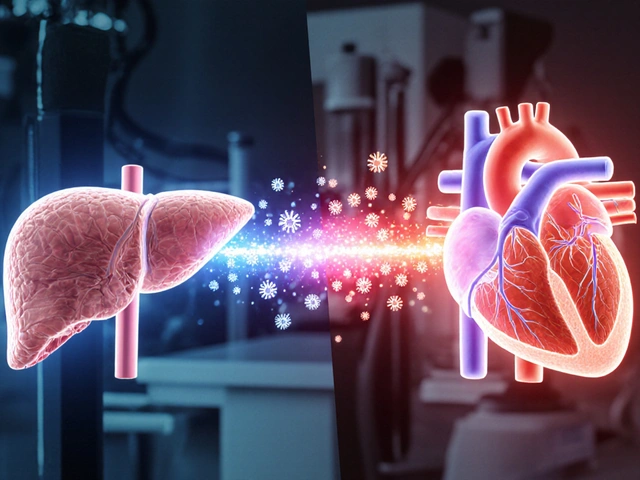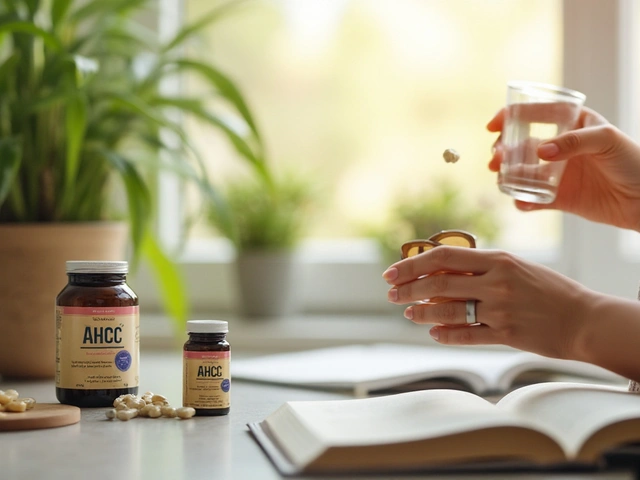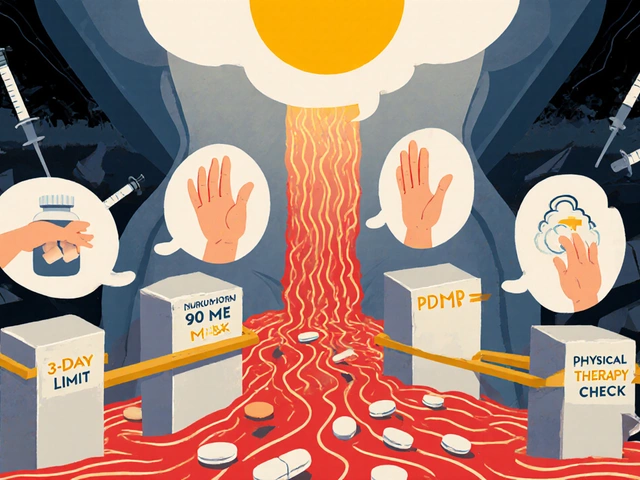You searched this because you want straight answers: What is Pravachol, how well does it lower cholesterol, what dose is right for you, and what should you watch out for? Here’s a no-drama, people-first breakdown you can actually use today. You’ll get the essentials, backed by respected sources like the FDA label (Pravachol, 2023 update) and major cardiology guidelines (ACC/AHA 2018 with 2022 updates), plus what clinical trials actually showed in real people.
- TL;DR:
- Pravachol (pravastatin) lowers LDL cholesterol and cuts heart attack and stroke risk; typical doses are 40-80 mg once daily.
- Best fits people needing a moderate LDL drop with fewer drug interactions; it’s hydrophilic, so it’s gentler on the liver-drug enzyme system.
- Common side effects: mild muscle aches, headache, stomach upset. Serious muscle injury is rare; call your clinician if you get severe muscle pain or dark urine.
- Grapefruit is not a big issue with pravastatin. Watch out for cyclosporine, gemfibrozil, and bile acid resins-those can change how it works.
- Expect an LDL check 4-12 weeks after starting or changing the dose, then every 3-12 months. Don’t double doses if you forget one.
What Pravachol Is, Who It’s For, and How It Works
Pravachol is the brand name for pravastatin, a statin used to lower LDL (bad) cholesterol and lower the risk of heart attack, stroke, and heart-related procedures. It’s been around for decades, and unlike some statins, it doesn’t rely heavily on the CYP3A4 liver enzyme, so it plays nicer with many other meds.
What it treats:
- High LDL cholesterol (primary hyperlipidemia) and mixed dyslipidemia.
- Prevention of cardiovascular events in people with risk factors or a history of coronary disease.
- In kids 8-18 with heterozygous familial hypercholesterolemia (when diet and lifestyle alone aren’t enough).
How it works in plain English: pravastatin blocks HMG-CoA reductase in the liver, a key step your body uses to make cholesterol. Lower production means your liver pulls more LDL out of your blood. Over time, that lowers plaque buildup risk and event risk.
How much it lowers LDL:
- 40-80 mg daily typically lowers LDL by about 30-35% (moderate intensity).
- 10-20 mg daily lowers LDL by less than 30% (low intensity).
What the outcomes data showed:
- WOSCOPS (men without prior heart attack, pravastatin 40 mg) showed fewer first heart attacks and lower coronary death.
- LIPID (pravastatin 40 mg in patients with prior heart events) showed fewer heart deaths and nonfatal heart attacks.
- PROSPER (older adults, pravastatin 40 mg) cut coronary events, especially in those who already had heart disease.
These trials anchor why doctors still prescribe pravastatin: not just better labs, but fewer bad outcomes. That’s the point.
| Dose (daily) | Intensity | Expected LDL drop | Key evidence |
|---|---|---|---|
| 10-20 mg | Low | <30% | Label-based efficacy; used when modest lowering is OK |
| 40 mg | Moderate | ~30-35% | WOSCOPS; LIPID; PROSPER |
| 80 mg | Moderate | ~35-40% (varies) | FDA label; clinical use when more lowering needed and tolerated |
Who tends to do well on pravastatin:
- People who need a moderate LDL cut and want fewer medication conflicts (e.g., multiple prescriptions, older adults).
- Those who had muscle aches on other statins; pravastatin can be easier to tolerate.
- Patients with a history of muscle issues on high-intensity statins but who still need statin benefits.
Who might need something stronger: if your LDL goal requires a 50% or greater drop (very high risk, very high LDL), high-intensity statins like atorvastatin or rosuvastatin, or add-ons like ezetimibe or PCSK9 inhibitors, may be better. Your clinician will align dose and drug to your risk and targets (based on ACC/AHA cholesterol guidance).
How to Take Pravachol: Dosing, Timing, Food, and Monitoring
Usual adult dosing:
- Start: 40 mg once daily. Some start at 10-20 mg if older, on interacting meds, or have kidney issues.
- Range: 10-80 mg once daily. Many land at 40-80 mg based on LDL response and tolerance.
Kids 8-18 with familial hypercholesterolemia: typical starting dose is 10-20 mg once daily; max often 40 mg in teens. Pediatric dosing is individualized-this is always a specialist-guided decision.
Timing rules that actually matter:
- Take it once a day at the same time. Nighttime has been the traditional pick, but consistency beats the clock. Morning is fine if you stick to it.
- With or without food-your call.
Missed dose:
- If you remember the same day, take it.
- If it’s almost time for the next dose, skip the missed one-don’t double up.
When you’ll see results: LDL starts dropping within 1-2 weeks and hits full effect by 4-6 weeks. Your clinician will usually check labs 4-12 weeks after starting or changing the dose.
Monitoring that keeps you safe and on track (based on FDA label and ACC/AHA guidelines):
- Baseline: Lipid panel and liver enzymes (ALT). CK only if you’ve had muscle problems before.
- Follow-up: Lipid panel 4-12 weeks after a dose change, then every 3-12 months. ALT again if symptoms suggest liver irritation (unusual fatigue, dark urine, yellowing of skin/eyes, severe nausea).
- CK only if you develop unexplained muscle pain/weakness, especially with fever or dark urine.
Interactions you actually need to remember:
- Bile acid resins (cholestyramine, colestipol): these bind pravastatin in the gut. Take pravastatin at least 1 hour before or 4 hours after the resin.
- Cyclosporine: raises pravastatin levels-often cap the dose at 20 mg and monitor closely.
- Gemfibrozil: boosts muscle risk with statins; avoid this combo if possible. If a fibrate is needed, fenofibrate is usually preferred with careful monitoring.
- Macrolide antibiotics (e.g., clarithromycin): less of an issue than with simvastatin/atorvastatin, but still tell your clinician if you’re prescribed one.
- Alcohol: heavy use raises liver risk; moderation matters.
- Grapefruit: unlike simvastatin, grapefruit isn’t a big deal with pravastatin; normal amounts are fine.
Special dosing situations:
- Kidney issues: you may start lower (e.g., 10 mg) and go slow.
- Liver disease: active liver disease or persistent high liver enzymes is a stop sign-this needs clinician input.
- Pregnancy and breastfeeding: routine statin use is avoided. FDA removed the old blanket contraindication in 2021 for rare high-risk cases, but for most people, statins are stopped if pregnant or trying to conceive. Breastfeeding is generally a no-go with statins.
Practical add-ons: If you need more LDL drop, ezetimibe is an easy, well-tolerated add-on. For very high risk or very high LDL, PCSK9 inhibitors or inclisiran can be layered on. Your LDL target and risk profile guide this.

Safety First: Side Effects, Red Flags, and How to Handle Problems
Most people do well on pravastatin. When issues show up, they’re usually mild and manageable. Here’s what to expect and what to do.
Common, usually mild:
- Muscle aches or stiffness (often symmetric, thighs/shoulders)
- Headache
- Stomach upset, nausea, diarrhea
- Sleep changes
Less common but important:
- Marked muscle injury (rhabdomyolysis): severe, sudden muscle pain, weakness, dark tea-colored urine. This is rare but urgent-stop the drug and seek care.
- Liver irritation: unusual fatigue, dark urine, yellowing of skin/eyes, right-upper belly pain-call your clinician.
- Blood sugar bump: statins can nudge glucose up slightly. The heart benefits usually outweigh this, and pravastatin tends to be on the gentler side in this area.
- Memory or mood shifts: reports are mixed; if it happens, talk to your clinician-switching statins or dose adjustments often fix it.
Who’s at higher risk for muscle problems:
- Older age, low body weight
- Thyroid problems (especially low thyroid), untreated
- Kidney disease
- Heavy exercise when you first start or when you bump the dose
- Gemfibrozil or cyclosporine on board
What to do if muscles ache:
- Don’t white-knuckle it. Call your clinician. They may check CK, hold the drug, and restart at a lower dose or switch statins once you feel better.
- Sometimes taking it every other day works for sensitive folks (clinician-guided).
- Vitamin D deficiency can mimic statin aches-worth checking. CoQ10 helps some people, though evidence is mixed.
Allergy-type reactions are rare (rash, swelling, trouble breathing). If that happens, seek care now.
Pregnancy, trying to conceive, breastfeeding:
- If you’re trying to get pregnant, talk to your clinician about pausing statin therapy and alternatives.
- If you become pregnant on pravastatin, call your clinician promptly. Don’t panic-risk to the baby from early exposure appears low-but care will be individualized.
- Breastfeeding: usually avoided while on a statin; discuss timing and options.
Checklists you can use:
- Before starting: bring a list of all meds and supplements; note any past statin issues; check baseline labs (lipids, ALT).
- First 12 weeks: note any muscle symptoms, new fatigue, or stomach issues; get your LDL checked at 4-12 weeks.
- Long-term: recheck lipids every 3-12 months; promptly report severe muscle pain, dark urine, or yellowing of skin/eyes.
Comparisons, Costs, and Smarter Alternatives
Pravastatin vs. other statins:
- Potency: Pravastatin is moderate intensity at 40-80 mg. If you need a 50%+ LDL drop, atorvastatin or rosuvastatin at higher doses usually do that better.
- Interactions: Pravastatin has fewer drug-drug interactions than simvastatin or lovastatin because it doesn’t rely on CYP3A4. This matters if you’re on multiple prescriptions.
- Tolerability: Many patients who struggled on stronger statins do fine on pravastatin. It’s not magic, but its hydrophilic profile seems gentler for some.
When pravastatin shines:
- Moderate LDL goals in people who take several other meds.
- Older adults where avoiding interactions is key.
- Patients with prior statin muscle symptoms who still need a statin’s outcome benefits.
When to consider alternatives:
- Very high-risk patients (recent heart attack, extensive plaque, diabetes with target-organ damage) where guidelines aim for ≥50% LDL reduction or very low LDL thresholds-high-intensity statin first-line.
- Familial hypercholesterolemia with LDL goals not met on moderate therapy-add ezetimibe; consider PCSK9 inhibitors or inclisiran.
- Documented statin intolerance-try low-dose rosuvastatin intermittently, or non-statin options guided by a lipid specialist.
Cost and access:
- Pravastatin is generic and inexpensive in the U.S.-many pharmacies offer a month’s supply for a low cash price. Insurance co-pays are usually modest.
- Brand-name Pravachol exists but is rarely needed over generic pravastatin.
Real-world scenarios (what I see people ask):
- “My LDL dropped only 22% on pravastatin 20 mg.” That’s expected at that dose. Options: increase to 40 mg, switch to a stronger statin, or add ezetimibe.
- “I had mild aches on atorvastatin 40 mg.” Two options: try pravastatin 40 mg or rosuvastatin at a lower or alternate-day dose. Track symptoms and labs.
- “I’m on cyclosporine after a transplant.” Pravastatin can be used at low doses with careful monitoring; your transplant team should steer this.
Decision cues you can trust (rules of thumb):
- If your 10-year ASCVD risk is high or you’ve had a heart event, ask your clinician whether you need a ≥50% LDL reduction. If yes, pravastatin alone probably isn’t strong enough.
- If your main concern is interactions or past muscle issues, pravastatin is a very reasonable starting point.
- If you’re within 5-10% of your LDL goal on pravastatin, adding ezetimibe is an easy, low-side-effect next step.
Quick answers (FAQ-style):
- Can I drink grapefruit juice? Yes, normal amounts are fine with pravastatin.
- Is it better at night? Night dosing is traditional, but take it when you can be consistent.
- Can it raise blood sugar? Slightly, in some people. The heart protection benefit usually outweighs this. Keep up with routine glucose checks if you’re at risk.
- How fast will my risk drop? Benefits start within months and build over years. Staying on it matters more than the perfect timing.
- Do I need CoQ10? Not required. Some try it for muscle symptoms; evidence is mixed.
Next steps and troubleshooting by situation:
- New to statins and nervous: start at 20-40 mg, keep a simple symptom journal for the first month, and book a 6-8 week lab check. Set a daily reminder on your phone.
- Getting aches after 2-3 weeks: call your clinician; consider a pause and restart at a lower dose, switch times (morning vs night), check thyroid and vitamin D, and discuss alternate-day dosing.
- LDL barely moved: confirm you’re taking it daily; review diet and fiber intake; consider increasing to 80 mg or adding ezetimibe. Recheck labs in 4-8 weeks.
- On multiple meds: have your pharmacist screen for interactions; if you add or stop any prescription, ask if it changes pravastatin dosing.
- Planning pregnancy: discuss stopping the statin and using non-drug approaches until after pregnancy; line up a plan for postpartum cholesterol management.
Why trust this guidance: it’s aligned to the FDA-approved labeling for Pravachol (latest revisions cited by the FDA) and the major cardiovascular guidelines used by clinicians (ACC/AHA 2018 guideline and 2022 updates). The big outcome trials (WOSCOPS, LIPID, PROSPER) are the backbone for pravastatin’s benefits. If your history is complex-transplant meds, muscle disorders, advanced kidney or liver disease-loop in your specialist and tailor the plan.
One last sanity check: the goal isn’t just a lower LDL number-it’s fewer heart attacks, strokes, and stents. If pravastatin gets you there with fewer hassles, stick with it. If it doesn’t, adjust early. That’s how you win this game.



![Buy Generic Topamax (Topiramate) Online Cheap Safely in the UK [2025 Guide]](/uploads/2025/08/thumbnail-buy-generic-topamax-topiramate-online-cheap-safely-in-the-uk-2025-guide.webp)


Grapfeut juice is cool with Pravachol, no big deal.
August 22Natalie Goldswain